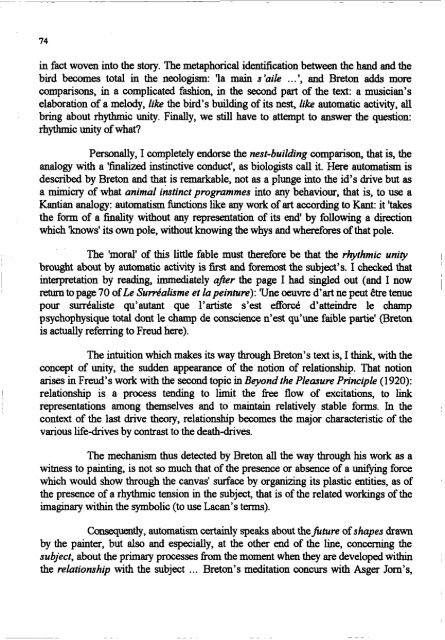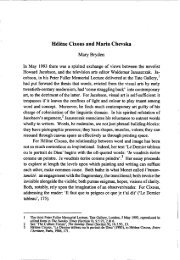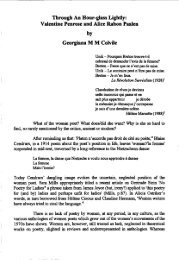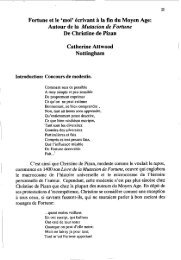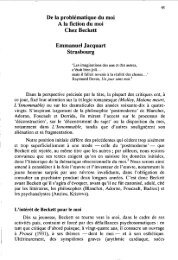The Poetics of Bricolage: André Breton's Theoretical Fables by ...
The Poetics of Bricolage: André Breton's Theoretical Fables by ...
The Poetics of Bricolage: André Breton's Theoretical Fables by ...
Create successful ePaper yourself
Turn your PDF publications into a flip-book with our unique Google optimized e-Paper software.
74<br />
in fact woven into the story. <strong>The</strong> metaphorical identitication between the hand and the<br />
bird becomes total in the neologism: ‘la main s’aile ...’, and Breton adds more<br />
comparisons, in a complicated fashion, in the second part <strong>of</strong> the text: a musician’s<br />
elaboration <strong>of</strong> a melody, like the bird’s building <strong>of</strong> its nest, like automatic activity, aU<br />
bring about rhythmic unity. Finally, we stiii have to attempt to answer the question:<br />
rhythmic unity <strong>of</strong> what?<br />
Pmnaily, I completely endorse the nest-building comparison, that is, the<br />
analogy with a ‘finalized instinctive conduct’, as biologists caii it. Here automatism is<br />
described <strong>by</strong> Breton and that is remarkable, not as a plunge into the id’s drive but as<br />
a mimicry <strong>of</strong> what animal instinct programmes into any behaviour, that is, to use a<br />
Kantian analogy: automatism functions like any work <strong>of</strong> art according to Kant: it ’takes<br />
the fonn <strong>of</strong> a ñnality without any representation <strong>of</strong> its end’ <strong>by</strong> following a direction<br />
which ’knows’ its own pole, without kuowing the whys and wherefm <strong>of</strong> that pole.<br />
<strong>The</strong> ‘moral’ <strong>of</strong> this littie fable must therefore be that the rhythmic unity<br />
brought about <strong>by</strong> automatic activity is first and foremost the subject’s. I checked that<br />
interpretation <strong>by</strong> reading, immediately affer the page I had singled out (and I now<br />
reaim to page 70 <strong>of</strong> Le Surkalisme et la peinture): ‘Une oeuvre d’ari ne peut être tenue<br />
pour surréaliste qu’autant que l’artiste s’est efforcé d’atteindre le champ<br />
psychophysique totai dont le champ de conscience n’est qu’une faible partie’ @reton<br />
is actually referring to Freud here).<br />
<strong>The</strong> intuition which makes its way through Breton’s text is, I îhk, with the<br />
concept <strong>of</strong> unity, the sudden appearance <strong>of</strong> the notion <strong>of</strong> relationship. That notion<br />
arises in Freud’s work with the second topic in Beyond the Pleasure Principle (1 920):<br />
relationship is a process tending to limit the fiee flow <strong>of</strong> excitations, to link<br />
representations among themselves and to maintain relatively stable forms. in the<br />
context <strong>of</strong> the last drive theory, relationship becomes the major characteristic <strong>of</strong> the<br />
various life-drives <strong>by</strong> contrast to the death-dnves.<br />
<strong>The</strong> mechanism thus detected <strong>by</strong> Breton aii the way through his work as a<br />
witness to painting, is not so much that <strong>of</strong> the presence or absence <strong>of</strong> a unifruig force<br />
which would show through the canvas‘ surface <strong>by</strong> organizing its plastic entities, as <strong>of</strong><br />
the presence <strong>of</strong> a rhythmic tension in the subject, that is <strong>of</strong> the related workings <strong>of</strong> the<br />
imaginary within the symbolic (to use Lacan’s terms).<br />
Consqmîly, automatism certainly speaks about thefuture <strong>of</strong> shapes drawn<br />
<strong>by</strong> the painter, but also and especially, at the other end <strong>of</strong> the line, c ondg the<br />
subject, about the primary processes fiom the moment when they are developed within<br />
the relationship with the subject ... Breton’s meditation concurs with Asger Joni’s,


